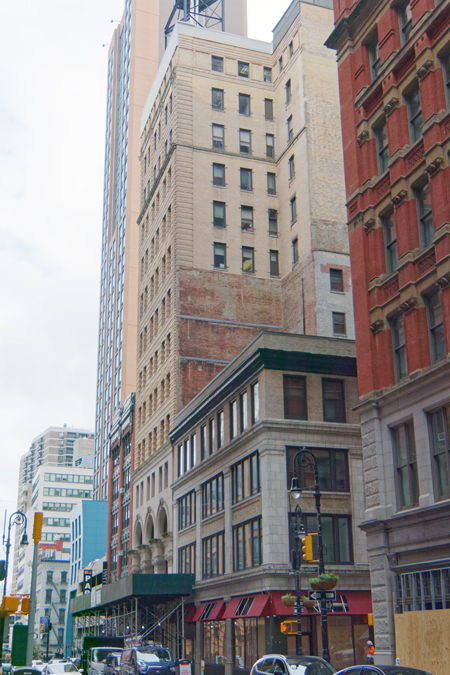University community fights to save historical building that Master Plan will demolish
August 4, 2020
As students scattered across the world in response to the pandemic’s school closures, the University was moving forward with Phase 3 of its Master Plan.
A campus expansion has been discussed in the past with little information available to the University community. However, an article by Matt Hickman in The Architect’s Newspaper reveals that demolition permits were filed in April for 15-19 Beekman St. by the University.
15 Beekman St, also known as the Vanderbilt Building, was designed by the renowned architectural firm of McKim, Mead & White and resides in Lower Manhattan’s Fulton-Nassau Historic District.
The historic district’s committee created a petition to preserve 15-19 Beekman St. as a New York City landmark. According to the petition’s description, “The Vanderbilt demolition project has been planned by Pace (and its developer partner SL Green) in complete secrecy. There was no community engagement whatsoever. Project plans were briefly posted on the Pace website, then mysteriously taken down with no explanation.”
“Furthermore, initial DOB findings indicate that Pace and SL Green may be seeking expedited demolition permits, in the midst of the current COVID-19 crisis—a deeply disturbing way to proceed,” it continued.
Details regarding the next steps of the Master Plan have since been re-uploaded to the University’s website.
Construction plans call for the demolition of the Vanderbilt as well as 126-132 Nassau, the corner building where the Dunkin’ is located. The buildings are said to be replaced with a 27-story campus hub of dorm rooms, dining facilities, classrooms and a library. It will also contain a cellar, sub-cellar and a 20-foot-long rear yard.
The east side of One Pace Plaza, which includes Maria’s Tower and the Michael Schimmel Center for the Arts will also be torn down.
On their website, the University explained, “One Pace Plaza East is more than 50 years old and requires extensive renovations and upgrades. By replacing it, we’re saving that money and gaining brand-new spaces.”
“Selling unused development rights—which cannot be transferred off this parcel— allows us to fund the project and add to our endowment. We’ll take advantage of the three years of Nassau Street construction to figure out the best use of the east side of One Pace Plaza to support our future plans,” they continued.
The University maintains that the new building will be completed before work starts on One Pace Plaza East and that construction is possible “without spending any tuition dollars or taking on new debt.”
In regards to the theater’s demolition, the website mentions, “Our performing arts programs are a big part of Pace and integral to our future. We’re committed to finding other performance spaces for our students to use during construction.”
The projected timeline says that construction will begin January 2021, with occupancy planned for September 2023.
University professor Martha Driver commented, “We are proud of the University’s legacy and our students, who are among the most responsible, intelligent and hard-working people I know, and I feel privileged to teach them. I believe our University would be an asset to any New York neighborhood, and the expansion further into downtown should be applauded.”
“Among other subjects, Pace students should be encouraged to understand history, especially the history of New York City where they live and study. The planned demolition by Pace of an historic building does not provide a good model for the preservation of our city’s history,” she added, “I would hope Pace can find a way to preserve this building to educate students directly about the history and culture of an earlier age, as well as to appreciate the Classical Revival style of the Vanderbilt.”
While the historic district the Vanderbilt resides in is designated on a state and federal level, it is not recognized as such by the city. Hickman writes, “Federal and state landmark status comes with a high level of prestige (in this case well-deserved) … it doesn’t impact private development.”
“It’s a city-granted designation that could ultimately halt the wrecking ball,” he continues.
University professor Erika Crispo said, “I am ashamed and astonished by the plans to demolish the historic and iconic Vanderbilt Building and the neighboring building. Some Pace faculty, myself included, believe that the façades of historic buildings should be preserved, in the way that any relic would be preserved such as in a museum. The interiors of the buildings can be renovated to suit the needs of landlords and tenants. I strongly support the designation of the Vanderbilt Building as a New York City Landmark which would provide it with protection.”
According to Hickman’s article, a full demolition permit for the buildings was processed on April 23 but has yet to be approved. Meanwhile, a permit for non-structural interior demolition work was submitted the same day and approved in early May.
A faculty member who declined to be named said, “Nearby buildings such as the Beekman Hotel use the existing structure in their renovations. I am a fan of new buildings however destroying an office tower unique to an architecture team would be like tearing down 41 Park Row, the original New York Times building. It is part of the special history of New York.”
Crispo continued, “It is clear that many people in the community outside of Pace are outraged by the plans, and thus Pace’s using it for classroom and dorm space would be bad for public relations. Furthermore, future students who would reside in the proposed new building might have feelings of guilt and shame to learn that their modern building was only made possible through the demolition of a piece of New York’s history. This does not bode well for Pace and sends bad karma. Pace should do better. We must be socially responsible and set good examples.”
The University’s Assistant Vice President for Government and Community Relations Vanessa J. Herman said, “The site at 15 Beekman/126-132 Nassau Street is a cornerstone of our New York City Master Plan. For the past several years, Pace has engaged in an extensive process to identify properties and options that will enable us to fulfill our mission of Opportunitas and meet the growing needs of our 21st century students. These studies had resulted in our conclusion that we would need to build our own space to meet our specific needs.”
She continued, “This particular location was brought to us as an ideal site for a new university building that will one day house a new residence hall, dining facility, library, learning center, classrooms, and academic and common spaces. This will unlock the full potential of our master plan without disrupting our campus life.”
The Pace Press will continue covering construction progress and how it will affect students as more information becomes available.













Jeffrey LeFrancois • Aug 17, 2020 at 8:36 pm
Has the local community board taken a position? Was an application ever filed with LPC? I’m a big fan of a Pace expansion and am relieved to hear they plan to demolish 1PP and Maria’s Tower (I cherish the memories though!), but destroying the Vanderbilt gem is shameful.
J. LeFrancois
Class of 2007